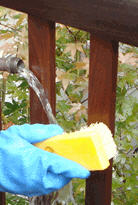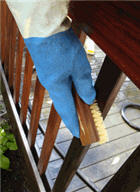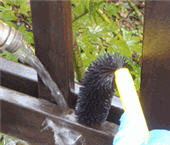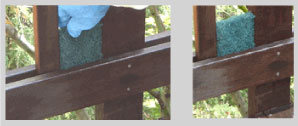
Custom Search
 The upright balusters, or 'spindles', and especially the thin ones, can be wrapped by a flexible scouring pad.
This can work on situations with 2" by 2"'s as well as the thinner 1" by 2"'s.
Working the pad in-hand will clean the surface areas of the uprights themselves and the bendable flex comes
in handy to apply added pressure to any surface irregularities. Two sides at a time can be cleaned. Too, the thin
pads are easily slid in-between or clear of any non-deck surface, such as house walls. This technique can save on time but
be cautious of splinters with your grasping hand - it might be wise to give each section a quick scan before doing this.
The upright balusters, or 'spindles', and especially the thin ones, can be wrapped by a flexible scouring pad.
This can work on situations with 2" by 2"'s as well as the thinner 1" by 2"'s.
Working the pad in-hand will clean the surface areas of the uprights themselves and the bendable flex comes
in handy to apply added pressure to any surface irregularities. Two sides at a time can be cleaned. Too, the thin
pads are easily slid in-between or clear of any non-deck surface, such as house walls. This technique can save on time but
be cautious of splinters with your grasping hand - it might be wise to give each section a quick scan before doing this.
 Tip: By sawing the ends off of a wood handled nail brush, nearer to the bristle-ferrules,
it then becomes able to reach tighter spots and angles.
Tip: By sawing the ends off of a wood handled nail brush, nearer to the bristle-ferrules,
it then becomes able to reach tighter spots and angles.
 If the balusters are cased in shoe boards, this presents a special challenge with the inner vestibule and the rigid stripping pad
can be slid right within it (upper and lower).
Another option is to wrap a flexible scour pad around a 1 1/2" putty knife and work it, that is if you can manage to keep it wrapped.
Lower casings are hit with a vigorous brush scrubbing, including the baluster end-cuts.
If the balusters are cased in shoe boards, this presents a special challenge with the inner vestibule and the rigid stripping pad
can be slid right within it (upper and lower).
Another option is to wrap a flexible scour pad around a 1 1/2" putty knife and work it, that is if you can manage to keep it wrapped.
Lower casings are hit with a vigorous brush scrubbing, including the baluster end-cuts.
 The slat floor is best done with a handled deck brush while exerting standing force, working in a continuous,
overlapping pattern. The slats are soon covered but should be gone over repeatedly to remove grime and inground particles
from foot traffic. Tilt the brush head into the wider plank gap edges (a contorting force on the strands).
The slat floor is best done with a handled deck brush while exerting standing force, working in a continuous,
overlapping pattern. The slats are soon covered but should be gone over repeatedly to remove grime and inground particles
from foot traffic. Tilt the brush head into the wider plank gap edges (a contorting force on the strands).